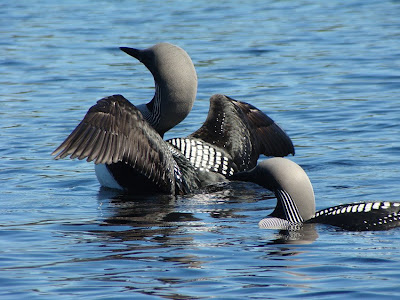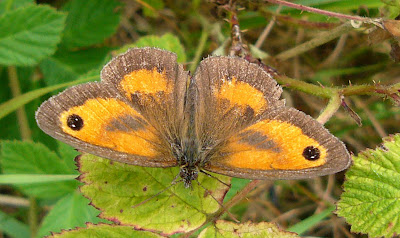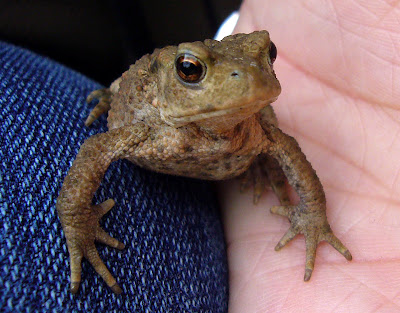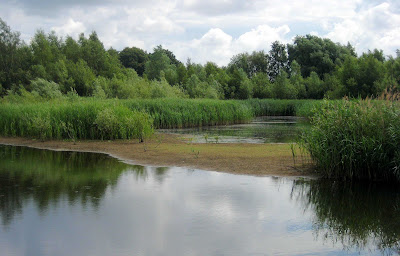Thursday 16 July 2009
blogging off...
Hi all - I'm away for much of the next 2 or 3 weeks and moving house after that so the blog won't be updated for a little while. However, please keep emailing me updates and pics and I'll post them all when I get back. Cheers, Pete
Wednesday 15 July 2009
a technique to remember...
A great tale just through from Jim - a chap called Robbie Walker was on a fishing trip from Dunnet Head, Scrabster at the weekend. There were about 30 Bonxies following the boat and he noticed 1 of the birds was ringed so their attention switched from catching fish, to catching birds. In the next half hour he manged to catch five Bonxies including the one with the ring which proved to be 20 yrs old. The method? Hold a fish in the air with one hand and grab with the other. So it's not just swans it works with then...


Sunday 12 July 2009
moult pic
Willow Tit paper
Good to see that the latest issue of British Birds contains a paper by SNRG friends Alex Lewis and Finn Stewart et al. on the decline of the Willow Tit. It's a very interesting read and makes you glad to live in this part of the world where they seem to be holding on fairly well.
Saturday 11 July 2009
Holme Pierrepont - 11 July
Well, our purple patch continues. Near perfect conditions once again and young birds were everywhere. We met at 0600h and packed up at 1300h having processed 142 birds. It's satisfying to have sights like this when it's gone 10 in the morning:
 Blackcaps and Reed Warblers continued to dominate the catch but both Lesser Whitethroat and Garden Warbler fledglings started to appear, the latter getting into double figures. Here are young Common and Lesser Whitethroats, both undergoing post-juvenile moult already:
Blackcaps and Reed Warblers continued to dominate the catch but both Lesser Whitethroat and Garden Warbler fledglings started to appear, the latter getting into double figures. Here are young Common and Lesser Whitethroats, both undergoing post-juvenile moult already:
 We are still catching the occasional unringed adult Reed Warbler. Whether such birds have been here for a while and somehow managed to evade the nets or they are wandering failed breeders, or even possibly very late arrivals, who knows? Below are two adult Reed Warblers showing extremes of coloration (yes, notch, emargination and wing length all checked...). The right hand bird is, in our experience, more typical, being more cold greyish-brown and faded and the left hand bird seems to have retained the warmer brown of a fresher bird (seen now in the juveniles).
We are still catching the occasional unringed adult Reed Warbler. Whether such birds have been here for a while and somehow managed to evade the nets or they are wandering failed breeders, or even possibly very late arrivals, who knows? Below are two adult Reed Warblers showing extremes of coloration (yes, notch, emargination and wing length all checked...). The right hand bird is, in our experience, more typical, being more cold greyish-brown and faded and the left hand bird seems to have retained the warmer brown of a fresher bird (seen now in the juveniles).
 OK - so perhaps it's not that obvious here, but it was fairly striking in the flesh...
OK - so perhaps it's not that obvious here, but it was fairly striking in the flesh...
We caught the first decent tit flocks of the season but remarkably in the last three weeks of enormous catches we have not caught a single Long-tailed Tit. We hear a few around, but you have to wonder whether they have had a poor year. We'll have to wait and see. Perhaps we'll catch 50 next week.
 Blackcaps and Reed Warblers continued to dominate the catch but both Lesser Whitethroat and Garden Warbler fledglings started to appear, the latter getting into double figures. Here are young Common and Lesser Whitethroats, both undergoing post-juvenile moult already:
Blackcaps and Reed Warblers continued to dominate the catch but both Lesser Whitethroat and Garden Warbler fledglings started to appear, the latter getting into double figures. Here are young Common and Lesser Whitethroats, both undergoing post-juvenile moult already: We are still catching the occasional unringed adult Reed Warbler. Whether such birds have been here for a while and somehow managed to evade the nets or they are wandering failed breeders, or even possibly very late arrivals, who knows? Below are two adult Reed Warblers showing extremes of coloration (yes, notch, emargination and wing length all checked...). The right hand bird is, in our experience, more typical, being more cold greyish-brown and faded and the left hand bird seems to have retained the warmer brown of a fresher bird (seen now in the juveniles).
We are still catching the occasional unringed adult Reed Warbler. Whether such birds have been here for a while and somehow managed to evade the nets or they are wandering failed breeders, or even possibly very late arrivals, who knows? Below are two adult Reed Warblers showing extremes of coloration (yes, notch, emargination and wing length all checked...). The right hand bird is, in our experience, more typical, being more cold greyish-brown and faded and the left hand bird seems to have retained the warmer brown of a fresher bird (seen now in the juveniles). OK - so perhaps it's not that obvious here, but it was fairly striking in the flesh...
OK - so perhaps it's not that obvious here, but it was fairly striking in the flesh...We caught the first decent tit flocks of the season but remarkably in the last three weeks of enormous catches we have not caught a single Long-tailed Tit. We hear a few around, but you have to wonder whether they have had a poor year. We'll have to wait and see. Perhaps we'll catch 50 next week.
Lots of birds are beginning to moult now and you wonder how some can even fly enough to find their way into the nets.
White Wag
Shiants 4
Jim is back on the mainland having ringed about 2000 birds. He also thinks he may have broken the Puffin longevity record yet again... More details and hopefully pics to follow.
Pete
Pete
Thursday 9 July 2009
More celebrity Pied Wags
The school pair has bred again and yesterday I ringed the 4 chicks with an audience of 60 Year 4s and several teachers all with their noses up against the window. The nest site is right outside the window of the school hall and it has become a popular pastime to spot the feed visits of mum and dad (which seem to average about every 2 minutes at the moment). The children found it hard to believe that it was only 5 weeks since the last brood were ringed and the fledged chicks of that brood are still seen around the place from time to time.
Pete
Pete
Shiants 3
Jim reports more Storm Petrels ringed and they're now on about 15 controls including a Portugese bird.
Monday 6 July 2009
Shiants - second update
Just spoken to Jim perched on those little rocks amid the Minch. They've had some good weather and the breeding season is clearly better than last year. They've ringed good numbers of auks and nearly 300 Storm Petrels. However, the highlight so far has been catching what is potentially the oldest ringed Puffin on record in the UK. Many of you will know that this is a record that Adrian Blackburn has consistantly chased and last year succeeded in breaking with a bird that was, I think 31 yrs, 351 days. Jim reckons this individual is 32 yrs and 8 days! Anyway - confirmation when Jim returns. Although of course, he may catch Adrian's old bird on Sule in a couple of week's time...
Sunday 5 July 2009
Holme Pierrepont - 5 July
Well we never expected a repeat of last week and the weather didn't look quite so promising, but it was another cracking morning. It was mainly scattered cloud with sunny spells, a very light breeze and a brief downpour as we took down at lunchtime. The main difference to last week though was that we felt the sun's power earlier and this slowed the session down sooner.
Nevertheless, we finished up on 141 birds processed. The catch was dominated by young birds and of the few adults we caught, several were beginning to moult. Blackcaps and Reed Warblers were top species again and the first smart young Sedges had fledged:
 We caught young of all common warblers with the exception of Lesser Whitethroat. Here's a handsome young Common Whitethroat:
We caught young of all common warblers with the exception of Lesser Whitethroat. Here's a handsome young Common Whitethroat:
 Not always obvious in the field, but fairly common once you start netting are adult female Reed Buntings such as this one which acquire surprisingly dark head patterns:
Not always obvious in the field, but fairly common once you start netting are adult female Reed Buntings such as this one which acquire surprisingly dark head patterns:
 Bullfinches were out as families today and we trapped several including this adult male.
Bullfinches were out as families today and we trapped several including this adult male.
 Sight records included 2 Curlew overhead, a single Hobby (narrowly missing a net...), a Grey Wagtail, a flock of high, soaring Cormormants and 2 Oystercatchers. At last the first Brown Hawkers appeared and a single Black-tailed Skimmer:
Sight records included 2 Curlew overhead, a single Hobby (narrowly missing a net...), a Grey Wagtail, a flock of high, soaring Cormormants and 2 Oystercatchers. At last the first Brown Hawkers appeared and a single Black-tailed Skimmer:
 The orchids have pretty much finished flowering, but the odd one was still there. I have to admit that I'm often guilty of making assumptions when it comes to flowers and I had remarked several times how tall one particular plant was without even considering it might not be a Common Spotted, but now I look carefully at the flowers I'm wondering if it is actually a Southern Marsh Orchid. Anyone care to comment?
The orchids have pretty much finished flowering, but the odd one was still there. I have to admit that I'm often guilty of making assumptions when it comes to flowers and I had remarked several times how tall one particular plant was without even considering it might not be a Common Spotted, but now I look carefully at the flowers I'm wondering if it is actually a Southern Marsh Orchid. Anyone care to comment?
Nevertheless, we finished up on 141 birds processed. The catch was dominated by young birds and of the few adults we caught, several were beginning to moult. Blackcaps and Reed Warblers were top species again and the first smart young Sedges had fledged:
 We caught young of all common warblers with the exception of Lesser Whitethroat. Here's a handsome young Common Whitethroat:
We caught young of all common warblers with the exception of Lesser Whitethroat. Here's a handsome young Common Whitethroat: Not always obvious in the field, but fairly common once you start netting are adult female Reed Buntings such as this one which acquire surprisingly dark head patterns:
Not always obvious in the field, but fairly common once you start netting are adult female Reed Buntings such as this one which acquire surprisingly dark head patterns: Bullfinches were out as families today and we trapped several including this adult male.
Bullfinches were out as families today and we trapped several including this adult male. Sight records included 2 Curlew overhead, a single Hobby (narrowly missing a net...), a Grey Wagtail, a flock of high, soaring Cormormants and 2 Oystercatchers. At last the first Brown Hawkers appeared and a single Black-tailed Skimmer:
Sight records included 2 Curlew overhead, a single Hobby (narrowly missing a net...), a Grey Wagtail, a flock of high, soaring Cormormants and 2 Oystercatchers. At last the first Brown Hawkers appeared and a single Black-tailed Skimmer: The orchids have pretty much finished flowering, but the odd one was still there. I have to admit that I'm often guilty of making assumptions when it comes to flowers and I had remarked several times how tall one particular plant was without even considering it might not be a Common Spotted, but now I look carefully at the flowers I'm wondering if it is actually a Southern Marsh Orchid. Anyone care to comment?
The orchids have pretty much finished flowering, but the odd one was still there. I have to admit that I'm often guilty of making assumptions when it comes to flowers and I had remarked several times how tall one particular plant was without even considering it might not be a Common Spotted, but now I look carefully at the flowers I'm wondering if it is actually a Southern Marsh Orchid. Anyone care to comment?Wednesday 1 July 2009
Tres bien!
Tonight's trip to the small Sand Martin colony at Attenborough produced only 13 birds in the 9m net. However, the total included 2 controls, one of which was wearing a Paris ring! To try and add a little side entertainment an 18m net was erected close to the ' near deserted' feeders and this produced a retrap Tree Sparrow and a new juv Great Spotted Woodpecker. Some of the team also managed to catch 3 new Egyptian Geese by hand. So a pleasant warm evening and a foreign control can't be too bad...
Kev

Kev

Shiants - first report
Got a text this morning from Jim which my phone says arrived at 03:46am. Whether that was when Jim sent it or not, who knows, but they had obviously reached the isles safely and had already caught 136 Storm Petrels including 3 controls!
More scandinavian beauties...
Inge still has her own photogallery pages on the University of Dundee website: http://www.maths.dundee.ac.uk/~ingeborg/personal.html
Many thanks for sharing these with us. Below are Black-throated Divers, Fieldfare (not in a situation we are accustomed to), a pair of Common Toads (begging for a caption), a male Redstart, some Barnacle Geese and a Redpoll.

Many thanks for sharing these with us. Below are Black-throated Divers, Fieldfare (not in a situation we are accustomed to), a pair of Common Toads (begging for a caption), a male Redstart, some Barnacle Geese and a Redpoll.

Stunning Swedish birds
It's mildly amusing to wonder who might chance upon our blog having googled something along the lines of this title. Anyway - as promised, some pictures from Inge taken in both Sweden and Finland. Below are Hawfinch, Common Crane, Grass Snake, Goosander, Red Squirrel and Hooded Crow. And before anyone comments, yes I do realise they are not all birds...


Subscribe to:
Posts (Atom)




 And there are still tiny toads wherever you walk in and around the reedbeds:
And there are still tiny toads wherever you walk in and around the reedbeds: More soon. Pete
More soon. Pete












